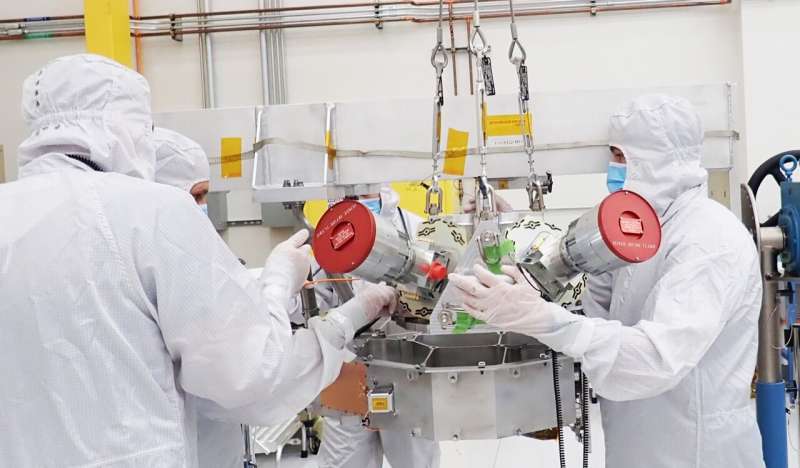Three months after its launch from NASA’s Kennedy Space Center in Florida, the agency’s Europa Clipper has another 1.6 billion miles (2.6 billion kilometers) to go before it reaches Jupiter’s orbit in 2030 to take close-up images of the icy moon Europa with science cameras.
Meanwhile, a set of cameras serving a different purpose is snapping photos in the space between Earth and Jupiter. Called star trackers, the two imagers look for stars and use them like a compass to help mission controllers know the exact orientation of the spacecraft—information critical for pointing telecommunications antennas toward Earth and sending data back and forth smoothly.
In early December, the pair of star trackers (formally known as the stellar reference units) captured and transmitted Europa Clipper’s first imagery of space. The picture, composed of three shots, shows tiny pinpricks of light from stars 150 to 300 light-years away. The starfield represents only about 0.1% of the full sky around the spacecraft, but by mapping the stars in just that small slice of sky, the orbiter is able to determine where it is pointed and orient itself correctly.
The starfield includes the four brightest stars—Gienah, Algorab, Kraz, and Alchiba—of the constellation Corvus, which is Latin for “crow,” a bird in Greek mythology that was associated with Apollo.

Hardware checkout
Besides being interesting to stargazers, the photos signal the successful checkout of the star trackers. The spacecraft checkout phase has been going on since Europa Clipper launched on a SpaceX Falcon Heavy rocket on Oct. 14, 2024.
“The star trackers are engineering hardware and are always taking images, which are processed on board,” said Joanie Noonan of NASA’s Jet Propulsion Laboratory in Southern California, who leads the mission’s guidance, navigation and control operations. “We usually don’t downlink photos from the trackers, but we did in this case because it’s a really good way to make sure the hardware—including the cameras and their lenses—made it safely through launch.”
Pointing the spacecraft correctly is not about navigation, which is a separate operation. But orientation using the star trackers is critical for telecommunications as well as for the science operations of the mission. Engineers need to know where the science instruments are pointed. That includes the sophisticated Europa Imaging System (EIS), which will collect images that will help scientists map and examine the moon’s mysterious fractures, ridges, and valleys. For at least the next three years, EIS has its protective covers closed.
Europa Clipper carries nine science instruments, plus the telecommunications equipment that will be used for a gravity science investigation. During the mission’s 49 flybys of Europa, the suite will gather data that will tell scientists if the icy moon and its internal ocean have the conditions to harbor life.
The spacecraft already is 53 million miles (85 million kilometers) from Earth, zipping along at 17 miles per second (27 kilometers per second) relative to the sun, and soon will fly by Mars. On March 1, engineers will steer the craft in a loop around the Red Planet, using its gravity to gain speed.
Citation:
En route to Jupiter, Europa Clipper captures images of stars (2025, February 4)
retrieved 4 February 2025
from https://phys.org/news/2025-02-en-route-jupiter-europa-clipper.html
This document is subject to copyright. Apart from any fair dealing for the purpose of private study or research, no
part may be reproduced without the written permission. The content is provided for information purposes only.

